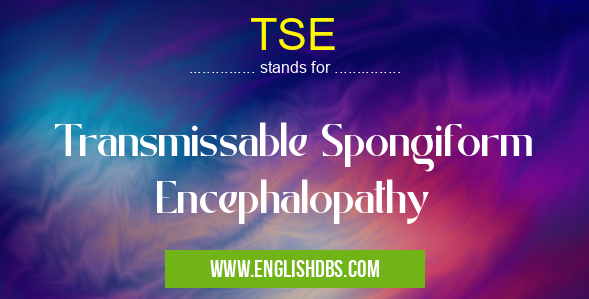What does TSE mean in UNCLASSIFIED
TSE (Transmissible Spongiform Encephalopathy) is a group of fatal, progressive neurological disorders that affect humans and animals. These diseases are characterized by the accumulation of abnormal proteins called prions in the brain, leading to spongy degeneration and neuronal loss.

TSE meaning in Unclassified in Miscellaneous
TSE mostly used in an acronym Unclassified in Category Miscellaneous that means Transmissable Spongiform Encephalopathy
Shorthand: TSE,
Full Form: Transmissable Spongiform Encephalopathy
For more information of "Transmissable Spongiform Encephalopathy", see the section below.
Meaning in MISCELLANEOUS
In the context of MISCELLANEOUS, TSE can refer to various topics related to medical terminology or scientific research. It may appear in scientific journals, medical textbooks, or online resources discussing infectious diseases, neurology, or animal health.
Full Form
- Transmissible Spongiform Encephalopathy
What does TSE Stand for
TSE stands for Transmissible Spongiform Encephalopathy. It encompasses a range of neurological diseases that are transmissible, meaning they can spread from one individual to another through direct contact or contaminated materials.
Essential Questions and Answers on Transmissable Spongiform Encephalopathy in "MISCELLANEOUS»UNFILED"
What is Transmissible Spongiform Encephalopathy (TSE)?
TSEs are a group of fatal neurodegenerative diseases that affect both humans and animals. They are characterized by the accumulation of abnormal proteins called prions in the brain, which leads to the formation of spongy holes and the death of brain cells.
What causes TSEs?
TSEs are caused by the misfolding of a normal brain protein called the prion protein (PrP). The misfolded form of the protein, known as PrPSc, is infectious and can spread to other individuals through contact with infected tissues or fluids.
How are TSEs transmitted?
TSEs can be transmitted through:
- Contact with infected brain or nervous system tissue
- Ingestion of infected meat or animal products
- Transplantation of infected organs or tissues
- Blood transfusions or blood products
- Contact with contaminated medical instruments
What are the different types of TSEs?
There are several different types of TSEs, including:
- Creutzfeldt-Jakob disease (CJD): The most common type of TSE in humans
- Variant Creutzfeldt-Jakob disease (vCJD): A variant of CJD that is linked to the consumption of beef from cattle infected with bovine spongiform encephalopathy (BSE)
- Fatal familial insomnia (FFI): A rare, inherited form of TSE
- Gerstmann-Sträussler-Scheinker syndrome (GSS): Another rare, inherited form of TSE
- Kuru: A TSE that was once prevalent among the Fore people of Papua New Guinea due to the practice of ritual cannibalism
What are the symptoms of TSEs?
The symptoms of TSEs vary depending on the type, but they can include:
- Rapidly progressive dementia
- Memory loss
- Personality changes
- Behavioral problems
- Movement disorders
- Speech difficulties
- Visual disturbances
- Seizures
- Muscle weakness
- Coma
How are TSEs diagnosed?
TSEs can be difficult to diagnose, as the symptoms can be similar to those of other conditions. Diagnosis typically involves a physical examination, neurological examination, and brain imaging tests. In some cases, a biopsy of brain tissue may be necessary to confirm the diagnosis.
Is there a cure for TSEs?
There is currently no cure for TSEs. Treatment is focused on managing the symptoms and providing supportive care.
How can TSEs be prevented?
There are a number of things that can be done to reduce the risk of TSEs, including:
- Avoiding exposure to infected brain or nervous system tissue
- Not consuming meat or animal products from animals that may be infected with a TSE
- Being cautious about receiving blood transfusions or organ transplants
- Using sterile medical instruments
- Practicing safe injection practices
Final Words: TSEs are a complex and devastating group of diseases that can have profound implications for both human and animal health. Understanding the nature, transmission, and potential treatments for these diseases is crucial for developing effective prevention and control strategies. Ongoing research continues to shed light on the mechanisms underlying TSEs, leading to advancements in diagnostics, therapeutics, and public health measures.
TSE also stands for: |
|
| All stands for TSE |
